
Cyprinodontiformes is an order of ray-finned fish, comprising mostly small, freshwater fish. Many popular aquarium fish, such as killifish and live-bearers, are included. They are closely related to the Atheriniformes and are occasionally included with them. A colloquial term for the order as a whole is toothcarps, though they are not actually close relatives of the true carps – the latter belong to the superorder Ostariophysi, while the toothcarps are Acanthopterygii.

The Scorpaeniformes are a diverse order of ray-finned fish, including the lionfishes and sculpins, but have also been called the Scleroparei. It is one of the five largest orders of bony fishes by number of species, with over 1,320.
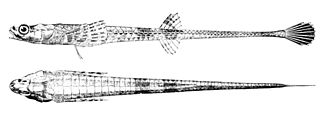
Agonidae is a family of small, bottom-dwelling, cold-water marine fish. Common names for members of this family include poachers, Irish lords, sea ravens, alligatorfishes, starsnouts, hooknoses, and rockheads. They are notable for having elongated bodies covered by scales modified into bony plates, and for using their large pectoral fins to move in short bursts. The family includes about 59 species in some 25 genera, some of which are quite widespread.
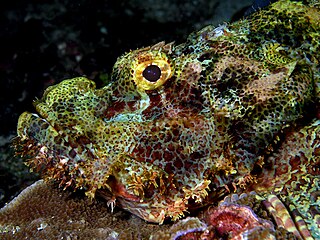
The Scorpaenidae are a family of mostly marine fish that includes many of the world's most venomous species. As their name suggests, scorpionfish have a type of "sting" in the form of sharp spines coated with venomous mucus. The family is a large one, with hundreds of members. They are widespread in tropical and temperate seas but mostly found in the Indo-Pacific. They should not be confused with the cabezones, of the genus Scorpaenichthys, which belong to a separate, though related, family, Cottidae.

Anoplopomatidae, the sablefishes, are a small family of ray-finned fishes classified within the order Scorpaeniformes. This family is the only family in the monotypic superfamily Anoplopomatoidea. These fishes are found in the North Pacific Ocean.

Rhamphocottidae is a family of ray-finned fishes belonging to the superfamily Cottoidea, the sculpins. The species in this family occur in the North Pacific Ocean.

Hexagrammidae, the greenlings, is a family of marine ray-finned fishes belonging to the suborder Cottoidei in the order Scorpaeniformes. These fishes are found in the North Pacific Ocean.

Bovichtidae, the temperate icefishes or thornfishes, is a family of marine ray-finned fishes, classified in the suborder Notothenioidei of the order Perciformes. They are native to coastal waters off Australia, New Zealand, and South America.
Pteroini is a tribe of marine ray-finned fishes, one of two tribes in the subfamily Scorpaeninae. This tribe includes the lionfishes, sawcheek scorpionfishes and turkeyfishes. The taxonomy of the scorpionfishes is in some flux; the 5th Edition of Fishes of the World treats this taxa as a tribe within the subfamily Scorpaeninae of the family Scorpaenidae within the order Scorpaeniformes, while other authorities treat it as a subfamily within a reduced family Scorpaenidae within the suborder Scorpaenoidei, or the superfamily Scorpaenoidea within the order Perciformes.
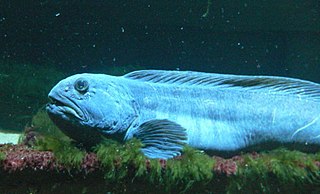
Zoarcoidei is a suborder of marine ray-finned fishes belonging to the order Scorpaeniformes. The suborder includes the wolffishes, gunnels and eelpouts. The suborder includes about 400 species. These fishes predominantly found in the boreal seas of the northern hemisphere but they have colonised the southern hemisphere.

The Zaniolepididae is a family of marine ray-finned fishes classified within the suborder Cottoidei of the order Scorpaeniformes. They are found in the North Pacific Ocean.

The oceanic basslets are ray-finned fish that belong to the small family Howellidae within the superfamily Percoidea of the suborder Percoidei part of the order Perciformes. The family includes about 9 species. They are mostly deep-water species, some of which move to shallower waters at night. Various species are found in the Indian Ocean, Pacific Ocean, including the Coral Sea, and Atlantic Ocean, including the Caribbean Sea.

Cottoidei is a suborder of ray-finned fishes which, according to the 5th edition of Fishes of the World, is placed within the order Scorpaeniformes, alongside the scorpionfishes, flatheads, eelpouts, sticklebacks and related fishes.
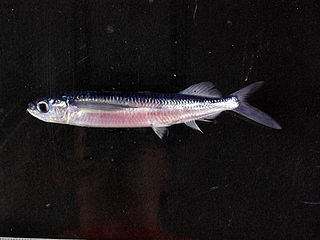
Exocoetoidei is a suborder of the order Beloniformes, which is sometimes known as the Belonoidei. It contains two superfamilies and five families.

Scomberesocoidea is a superfamily within the suborder Exocoetoidei of the order Beloniformes. It consists of two families which are commonly known as the needlefishes and the sauries.

Exocoetoidea is a superfamily of fishes that comprises three families, the flying fishes, the halfbeaks and the viviparous halfbeaks. They are found in tropical and subtropical waters around the world. Exocoetoidea is part of the suborder Exocoetoidei of the order Beloniformes.

Cyprinodontoidei is a suborder of fishes, one of the two suborders in the order Cyprinodontiformes. The Cyprinodontoidei consists of four superfamilies which are found in the Americas, the Mediterranean and in Africa, including Madagascar.
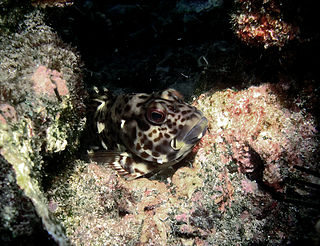
Cirrhitoidea is a superfamily within the suborder Percoidei of the large order of ray-finned fishes, the Perciformes.

Siganoidea is a superfamily belonging to the suborder Percoidei which in turn is the largest suborder of the order Perciformes. It contains two families of largely Indo-Pacific distribution.

Scorpaenini is a tribe of marine ray-finned fishes, one of two tribes in the subfamily Scorpaeninae. This tribe contains the "typical" or "true" scorpionfishes. The taxonomy of the scorpionfishes is in some flux, the 5th Edition of Fishes of the World treats this taxa as a tribe within the subfamily Scorpaeninae of the family Scorpaenidae within the order Scorpaeniformes, while other authorities treat it as a subfamily within a reduced family Scorpaenidae within the suborder Scorpaenoidei, or the superfamily Scorpaenoidea within the order Perciformes.



















